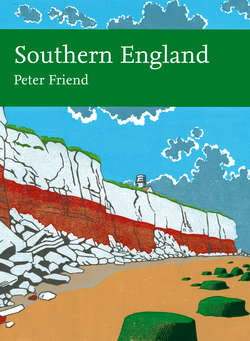Читать книгу Southern England - Peter Friend - Страница 31
Younger episodes Sedimentary markers
ОглавлениеBetween 7 and 20 km to the southwest of Exeter, traversed by the A38 and A380 trunk roads, the Great and Little Haldon Hills are capped by a layer of sediments, assigned to the Upper Greensand, and spanning in age the Early/Late Cretaceous boundary (between about 105 and 95 million years ago). These are the westernmost erosional relicts of a continuous sheet of sediment of this age that extended across much of the rest of Southern England. In the Haldon Hills area, the sandy and fossiliferous material seems to have formed near the coastal margin of an extensive Cretaceous sea.
The Haldon Gravels are distinctive deposits that occur above these Cretaceous sediments. They consist largely of flint pebbles and contain sand and mud between the pebbles. Some of the gravels appear to be the result of removal by solution of the calcareous Late Cretaceous Chalk that can no longer be found in its unaltered state so far west. The flint nodules in the Chalk were then left as a layer of much less soluble pebbles. Some of the gravel appears to have been carried to its present position by rivers or the sea, perhaps also with the incorporation of kaolinite clay from the Dartmoor granite. The age of these gravels appears to be early Tertiary, perhaps about 55 million years.
A few kilometres west of the Haldon Hills, northwest of Torquay, the Bovey Formation of early Tertiary age (Eocene and Oligocene, about 45 to 30 million years ago) occurs in a distinct, fault-bounded basin. The formation is more than 1 km in thickness and consists primarily of the clay mineral kaolinite, deposited as mud by local streams, and associated with minor amounts of sand, gravel and peat-like organic deposits of lignite. This sediment fill continues to be a very important material for ceramics, pipes, tiles etc. ranging from high-quality china clay to lower-quality materials. Most of the sediment appears to have been carried into the basin from the area of the Dartmoor granite and its surroundings. The Bovey Basin formed as a result of subsidence along the northwest-to-southeast trending Sticklepath Fault Zone (Fig. 39) which cuts across the whole of the Southwest Region. This fault zone seems to have been active during the accumulation of sediment in the basin and so, at least in this phase of its history, it was much younger than the Variscan structures of the Southwest generally. Further to the northwest along the same fault zone is the smaller Petrockstowe Basin near Great Torrington (see Fig. 38), and, offshore, under the Bristol Channel is the larger Stabley Bank Basin, east of Lundy Island.
About 6 km southeast of St Ives (see Area 1), near the small village of St Erth, a small area is underlain by some soft sands and muds. When first exposed by quarrying, these sediments provided a rich assemblage of fossils that are thought to have lived some 3 million years ago, in latest Tertiary times. The fossils suggest sea depths of between 60 and 100 m, and are now about 30 m above sea level, so they provide a fragment of evidence from a period when the sea was more than 100 m higher than it is now, relative to the land of Cornwall. As will be mentioned below, this deposit is rather similar in its elevation to the most obvious plateau recognised in many of the inland areas, which may also relate to an episode when the sea stood at this level.
